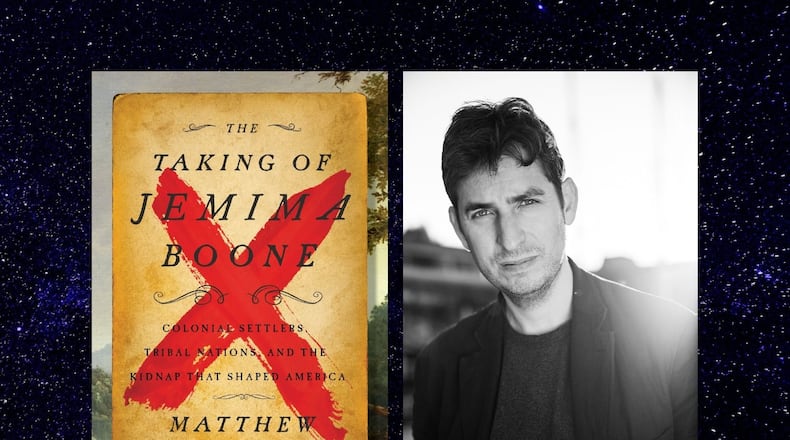New York Times bestselling novelist Matthew Pearl presents a comprehensive and enlightened account of the complex battle for North America’s frontier in his nonfiction debut, “The Taking of Jemima Boone: Colonial Settlers, Tribal Nations, and the Kidnap That Shaped America.”
On a sweltering summer day in 1776, three teenage girls living in the settlement of Boonesboro hop into a canoe seeking a refreshing ride down the Kentucky River. Jemima Boone, Daniel Boone’s 13-year-old daughter, and two friends, the Callaway sisters, are quickly apprehended by a group of renegade Shawnee and Cherokee warriors led by Cherokee leader Hanging Maw.
Pearl draws the reader into the ramifications of Jemima’s kidnapping, and the lasting impact this triggering event unleashes on the quest for control of unsettled America, through an in-depth examination of the tempestuous climate of 1770s frontier life.
The encounter between Jemima and Hanging Maw is not their first. “Hanging Maw recognized Jemima from Sycamore Shoals,” the treaty negotiations for a 20-million-acre land purchase he attended as a tribal representative the year before. Subsequently, settlers have moved in and started brutally ousting Native Americans from land they claim is under their sole control. But Cherokees aren’t the only indigenous people to have inhabited this land for thousands of years. Boonesboro becomes one of many settlements threatening the Shawnee community’s hunting grounds.
Believing a future of unimpeded westward expansion would end their way of life, intertribal factions are formed to fight the settlers’ progress. Hanging Maw, out on one such mission, assesses Jemima’s capture as “a chance for the tribes to gain leverage on a central figure of the frontier.”
Tribal kidnappings were common in 1776 but did not necessarily lead to “blood feuds” or violence, as they frequently have been portrayed throughout history. Pearl provides multiple examples of how “relations between settlers and Indians on the frontier ranged in a wide spectrum; they could be allies, could live among one another, could intermarry, or could be sworn enemies.” Adopting kidnapped settlers, especially women and children, into a tribe as reparations or a replacement for the loss of a Native American’s life “helped tribes rebuild their communities and families.”
In the face of Jemima’s abduction, Daniel Boone launches a rescue party. Aided by Jemima’s quick thinking, clandestine clue dropping and her savvy play on “the perception of female weaknesses,” his party tracks down the girls before they are taken to a Shawnee town. In the process of securing their safety, Daniel kills Catfish, one of the captors and son of the esteemed Shawnee War Chief Blackfish.
Although Jemima and her friends’ kidnapping sparks a tangled chain of back and forth between settlers and Native Americans, Pearl firmly establishes that “the ricochet of violence and retaliation crisscrossing the American frontier” is already strongly rooted. Dunmore’s War had been launched a few years before when bloodthirsty settlers “eviscerated a pregnant Indian woman, impaling the fetus on a stake.”
The Revolutionary War is also in full swing and puts “increased pressure on tribal factions to commit to alliances or become enemies of one side or the other.” There are fierce disagreements between tribes and within tribes over which side, if any, to support. As a bevy of different groups fight for access to this contested land, Pearl brings to life a frontier that “remained in limbo, caught in a struggle among Indians, settlers, the British, and nature itself.”
This multi-spoked tug-of-war leads to Daniel’s eventual capture by Blackfish. Jemima’s father is presumed dead by the rest of her family, who scatter for more settled lands, but her fierce loyalty and belief in Daniel’s ability to endure keeps her in Boonesboro.
Every bit as fearless and determined as Daniel, Jemima plays a pivotal role in defending the settlement against Blackfish’s siege and securing her father’s return. If Blackfish had been successful, Theodore Roosevelt later speculated, “the small population of settlers in Kentucky would have been swept out” and the British could have won The Revolutionary War. Yet Jemima’s contribution, like many women throughout history, has been lost in the mist of time.
Although Daniel plays a prominent role in this narrative, Pearl consistently brings the story back to Jemima and her importance in history. “Generally presented as a victim rather than the fighter, survivor, and leader she was,” Jemima was actually “taken” twice, Pearl asserts: Once in 1776 when snatched from a canoe, and again when she was written out of her own historical narrative. When Jemima is portrayed, her story is “warped and sensationalized” to fit the prevailing female stereotype.
Charles Wimar’s 19th century painting “The Abduction of Daniel Boone’s Daughter by the Indians” erases even her name from historical record. James Fenimore Cooper’s novel “The Last of the Mohicans,” which “was viewed as a kind of dramatized Boone family biography” at the time of its 1826 publication, portrays Jemima’s counterpart as a doomed character whose fate was determined by men.
Even her own words were lost when the pages of her autobiography went down with the cargo of a wrecked river vessel, no copies having been made. Pearl’s focused and illuminating effort to weave Jemima’s significance back into the public consciousness seeks to right this injustice. Simultaneously, he successfully presents a well-rounded portrait of a period in time historically slated with a bias toward the settlers. The result is a work that provides an equally educational and fascinating experience.
NONFICTION
by Matthew Pearl
HarperCollins
272 pages, $27.99
About the Author
The Latest
Featured

